Human Flower Project
Radicles from the Afghan Front
Two years after its seed was collected in a remote Afghan village, a tiny cedar settles into its new Kentucky home.
 Cedrus deodara (at right) in the Kullu Valley of NW India
Cedrus deodara (at right) in the Kullu Valley of NW India
Photo: via wiki
By Allen Bush
The Himalayan cedar barely got a nod last month at the silent auction in Louisville, Kentucky. Jack Alexander from the Arnold Arboretum of Harvard University had donated a tiny Cedrus deodara but the seedling was far from the most fetching plant on the block. The little tree (auction item # 61) had a story with a bare bones bid-sheet teaser: “Collected from wild Waygal District Nuristan Province Afghanistan. “ No commas, no more details.
Afghanistan’s President Hamid Karzai held a loya jirga this week in Kabul, 2,000 elders gathering to sip tea and try to untangle their country’s problems. Louisville’s pow-wow – the 61st annual meeting of the Eastern Region of the International Plant Propagators Society, —drew a smaller crowd: some 150 folks sampling Kentucky Bourbon and fretting over the siege of the emerald ash borer.
Across the auction room at the Seelbach Hotel, there was a huddle around Parrotia subaequalis, a witch hazel relative recently introduced from China. The day before, visiting nurserymen, academics and representatives from arboreta and botanic gardens had seen a small 4’ (1.2 m) tall planting at Yew Dell in Crestwood. Those standing in the cold drizzle erupted in oohs and aahhs, sparked by the rich burgundy fall foliage. This plant’s relative, the Persian ironwood Parrotia persica, never quite reaches the autumnal expectations of brilliant oranges and reds as advertised—at least not in the Midwest. But its Chinese cousin delivered the fall goods at Yew Dell, in plain sight. The top bid for the rare Parrotia was $280.00.
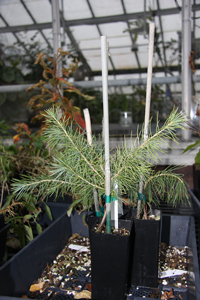 Cedrus deodara: Afghan seed sowed and growing at Arnold Arboretum, Harvard
Cedrus deodara: Afghan seed sowed and growing at Arnold Arboretum, Harvard
Photo: Jack Alexander
But I took home the little deodar cedar for $10.00. (At the time, I didn’t know that the original seeds of the disjunct population of Cedrus deodara had been collected for the French Forest Service in the Afghan village of Jamach exactly two years before, on October 25, 2009.) The symposium plant lovers knew deodar cedar. It’s not rare, nor is it widely appreciated in North America. None of that mattered. The $10.00 winning bid was my grand prize. I tucked the seedling into a nurse bed in the back garden, near a stone wall, the next day.
Jack Alexander, Arnold Arboretum’s Plant Propagator, had to work magic before he could bring my prize to Louisville. He emailed the details: “I sowed the seed: About 170 seed were stratified for 2 months, sown 3 May 2010 (radicles were emerging) approx. 40 germinated.”
“It is necessary to propagate some of the garden varieties by grafting on their typical forms, but they are of little importance. Trees raised from seed will always grow better and give the greater pleasure.”
—From the introduction to the genus Cedrus in W.J. Bean Trees and Shrubs Hardy in the British Isles, Eighth edition, Volume I, 1914. Revised, 1976.
I didn’t need to tell Jack Alexander about the greater pleasure of growing seeds. Jack has been sticking cuttings, grafting and sowing seeds at the Arnold since 1976.
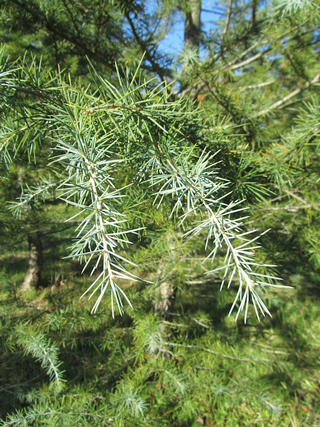 The needles of Cedrus deodara, Goshen Gardens Nursery and Landscaping, Goshen, KY
The needles of Cedrus deodara, Goshen Gardens Nursery and Landscaping, Goshen, KY
Photo: Allen Bush
Cedrus deodara, a native evergreen of the Western Himalayas from Afghanistan to Western Nepal, is the national tree of Pakistan. The needles are as sharp as tiny spears and colored in shades from dark green to silvery blue-green. The tree is revered among Hindus as a holy tree; the Sanskrit vernacular for the Himalayan Cedar is devadaru, “wood of the gods.”
The conifer can reach heights of over 150’ (45 m), with a comparable wingspan in its native range and in Europe. (One especially impressive specimen in Abbottabad, Pakistan, was planted around 1850 on the grounds of the military compound, just down the street from Osama bin Laden’s last hideout.) But no one imagines it will reach proportions like this in the Eastern United States. Michael Dirr, author of The Manual of Woody Landscape Plants, reports a host of problems for the Eastern U.S., including top die back and cold.
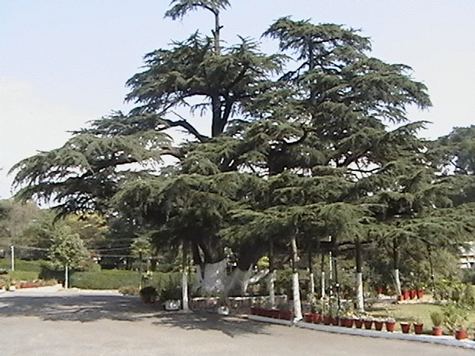
Immense Cedrus deodara in Abbottabad: the national tree of Pakistan
Photo: Pakistanpedia
Cedrus deodara is grown in the south, and along the west coast, where it can reach heights approaching 60’ (18 m). Lee Squires, Superintendent, Secretary & Treasurer of Louisville’s Cave Hill Cemetery, said the cedars there were killed in the very cold winter of 1978, when the Ohio River froze over and temperatures went to -20 F (-29 C). But Louisville is barely Southern—geographically. In spite of Southern accents that might mislead, the weather is more Midwestern.
Dirr suspects the species may only be cold hardy to -12 F (-24 C), and that even this might be overreaching. He says that the cultivar ‘Shalimar’ may be the hardiest selection to date. It was collected in the Shalimar Garden in Srinagar, Kashmir, in 1964, and subsequently introduced by the Arnold Arboretum. There have been reports of ‘Shalimar’ surviving winter temperatures as low as -15 F (-26 C). Forms of Cedrus atlantica, the Atlas cedar, and Cedrus libanii, the cedar of Lebanon, are considered a bit cold hardier than the deodar cedar.
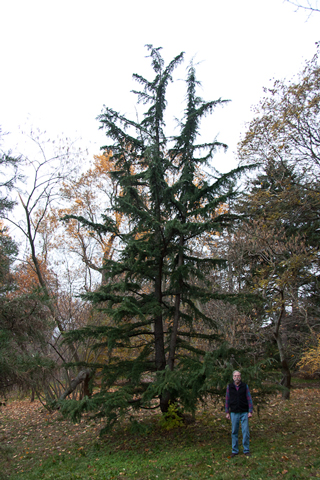 At Arnold Arboretum, Jack Alexander with ‘Shalimar,’ a C. deodara that can survive Boston’s winters
At Arnold Arboretum, Jack Alexander with ‘Shalimar,’ a C. deodara that can survive Boston’s winters
Photo: Oren McBee
Michael S. Dosmann, Curator of Living Collections at the Arnold Arboretum, emailed me about the Afghan deodar cedar: “…this accession is one of the more notable additions to the Arnold in the past few years and we look forward to seeing how the plants perform in the collection once they are old enough to be planted out.” Dosmann says that while ‘Shalimar’ has proven hardy even through Boston’s cold winters, he expects that the Afghan C. deodara will be difficult to grow. Still, he writes, “With this disjunct population, however, there is hope!”
Dosmann gave me background about the tree’s French connection: Arnold Arboretum received the seed from Thierry Lamant of the Office of National Forests (formerly of the Arboretum National Des Barres). Dosmann wrote that Lamant had “obtained the seed from Jean Braud, of the French Forest Service, who collected it in Afghanistan.”
The locality information that Braud gave to Lamant, “was a bit sparse,” Dosmann wrote, “but sometimes that is all we can work with. A village name (Jamach) and district/county (Waygal/Nuristan) isn’t that bad. Beats going there to collect it on our own!”
Nuristan Province, northeast of Kabul, is remote, mysterious and dangerous. (Eric Newby’s A Short Walk in the Hindu Kush provides a fascinating cultural account of Nuristan, besides being a great adventure story.) The towering mountains of the Hindu Kush sit at the northern end of Nuristan, and the Pech Valley serves as a conduit for Al Qaeda from neighboring Pakistan to the east. The province had been known as Kafirstan until the Great Emir Abdur Rahman Khan converted the stubborn Kafirs (blasphemers of Allah) to Islam “by sword” in 1895-96.
Alexander the Great met resistance here in the 4th Century B.C. The British got their clock cleaned in three Afghan-Anglo wars ending in 1919. And the Russians met their match, 1978-1988. Then there was civil war followed by the rise, fall and resurgence of the Taliban. All told, there have been centuries of skirmishes on hillsides and valleys filled with primroses, Potentillas, Artemisias and death.
In 2008 an American platoon was overrun in the Waygal village of Wanat. By February 2011, American troops began leaving Waygal District. In March, with the Afghan National Forces feebly attempting to fill the void, the Taliban claimed control of the entire District.
Frenchman Jean Braud was simply interested in trees. Braud maintained excellent local contact, even during times of Taliban rule. According to Thierry Lamant from France’s Office of National Forests, “The country remains dangerous but Jean and his colleagues know the people and act so as not to get into trouble.” And the local contacts made good, collecting seeds for Braud and the French Forest Service.
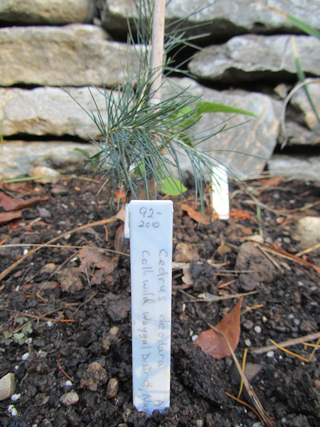 Tucked into the nurse bed, the Afghan seedling will face its first Kentucky winter
Tucked into the nurse bed, the Afghan seedling will face its first Kentucky winter
Photo: Allen Bush
The new cedar is easing into dormancy, waiting to see what the winter brings. It’s quiet, now, and peaceful. I hope the Afghan cedar will survive a long, fruitful life in Kentucky. The stone wall will give it a little protection for a few years, but then it will be planted out and be on its own. Other newcomers keep the seedling company for the time being. Robert Wilson gave me a grafted Korean fir, Abies koreana, over five years ago. It’s pokey and has grown only 6” (15 cm), but I still can picture blue cones one day. (Photos look magnificent!) Yucca glauca was a gift from Kirk Alexander who collected the dry land species in the Nacimiento Mountains west of Santa Fe near Cuba, New Mexico. It’s adapted for 10” (25 cm) of annual precipitation – or less – and doesn’t have any business being so happy with the 55” (140 cm) of rain we’ve had so far this year. And Julian Campbell passed along an Eastern Kentucky, low-growing, yellow flowering perennial, Hypericum sphaerocarpum, with glossy linear leaves. He found this on rocky limestone ledges close to the Little South Fork of the Cumberland River near Monticello, Kentucky. I am a blessed soul with friends who share the plants they love so much.
My grand prize this year is from the Arnold Arboretum’s Jack Alexander, who generously donated the auction plant. In my view, there’s something noble about wild collected seeds from a war-torn hot spot ending-up two years later as a seedling in my quiet backyard. There will be challenges for sure. The Waygal District is considerably drier in summer than the Ohio Valley. Will the cedar handle a 4” (10cm) July deluge? Time will tell.
And there are other concerns on my home front. This past spring, two Iraqi refugees living in Bowling Green, Kentucky, were arrested on charges that that they were trying to export arms – rifles, Stinger missiles and money—to an Al Qaeda group in Iraq. Nobody on either side of this conflict is getting their hands on my little cedar.

